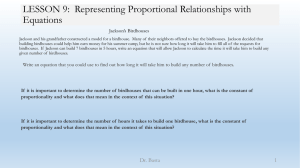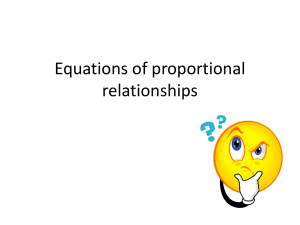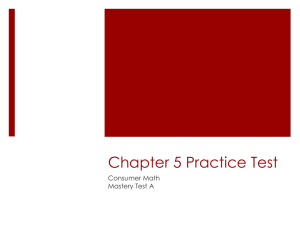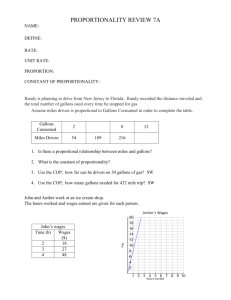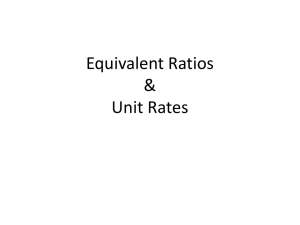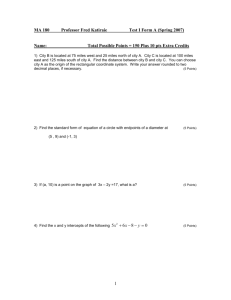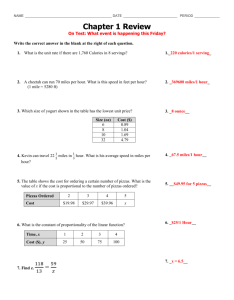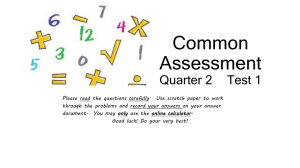Lesson 9: Representing Proportional Relationships
advertisement
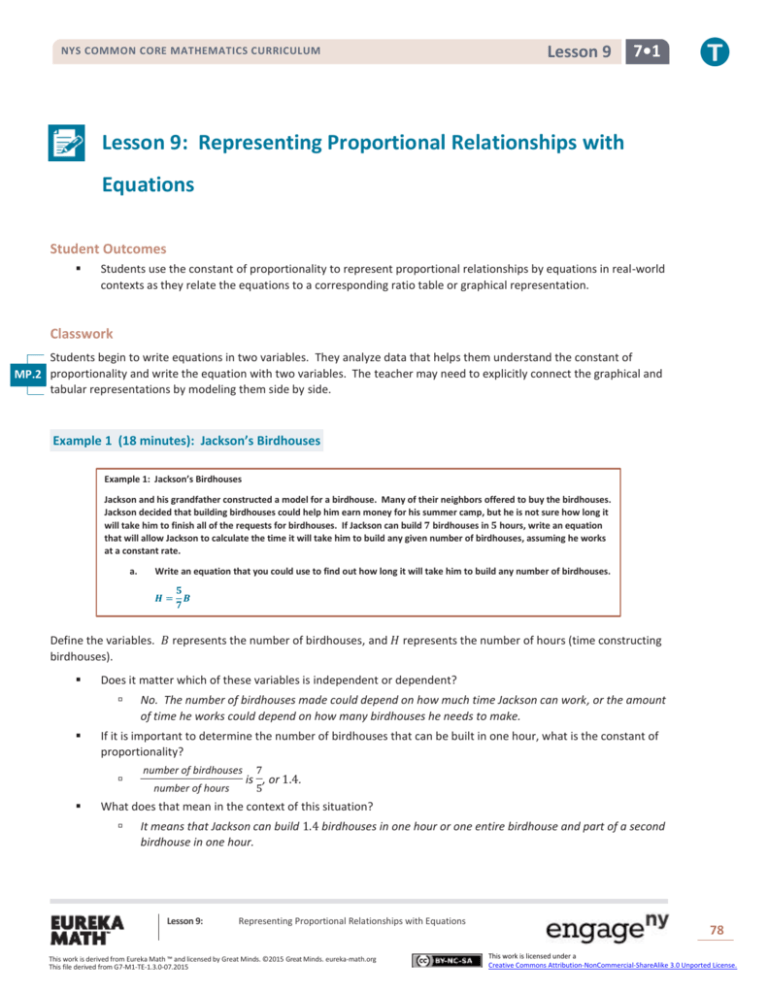
NYS COMMON CORE MATHEMATICS CURRICULUM Lesson 9 7•1 Lesson 9: Representing Proportional Relationships with Equations Student Outcomes Students use the constant of proportionality to represent proportional relationships by equations in real-world contexts as they relate the equations to a corresponding ratio table or graphical representation. Classwork Students begin to write equations in two variables. They analyze data that helps them understand the constant of MP.2 proportionality and write the equation with two variables. The teacher may need to explicitly connect the graphical and tabular representations by modeling them side by side. Example 1 (18 minutes): Jackson’s Birdhouses Example 1: Jackson’s Birdhouses Jackson and his grandfather constructed a model for a birdhouse. Many of their neighbors offered to buy the birdhouses. Jackson decided that building birdhouses could help him earn money for his summer camp, but he is not sure how long it will take him to finish all of the requests for birdhouses. If Jackson can build 𝟕 birdhouses in 𝟓 hours, write an equation that will allow Jackson to calculate the time it will take him to build any given number of birdhouses, assuming he works at a constant rate. a. Write an equation that you could use to find out how long it will take him to build any number of birdhouses. 𝑯= 𝟓 𝑩 𝟕 Define the variables. 𝐵 represents the number of birdhouses, and 𝐻 represents the number of hours (time constructing birdhouses). Does it matter which of these variables is independent or dependent? If it is important to determine the number of birdhouses that can be built in one hour, what is the constant of proportionality? No. The number of birdhouses made could depend on how much time Jackson can work, or the amount of time he works could depend on how many birdhouses he needs to make. number of birdhouses number of hours 7 is , or 1.4. 5 What does that mean in the context of this situation? It means that Jackson can build 1.4 birdhouses in one hour or one entire birdhouse and part of a second birdhouse in one hour. Lesson 9: Representing Proportional Relationships with Equations This work is derived from Eureka Math ™ and licensed by Great Minds. ©2015 Great Minds. eureka-math.org This file derived from G7-M1-TE-1.3.0-07.2015 78 This work is licensed under a Creative Commons Attribution-NonCommercial-ShareAlike 3.0 Unported License. Lesson 9 NYS COMMON CORE MATHEMATICS CURRICULUM If it is important to determine the number of hours it takes to build one birdhouse, what is the constant of proportionality? number of hours 7•1 number of birdhouses 5 5 7 7 is , or 0.71, which means that it takes him of an hour to build one birdhouse or 5 ( ) (60) = 43 minutes to build one birdhouse. 7 This part of the problem asks you to write an equation that will let Jackson determine how long it will take him to build any number of birdhouses, so we want to know the value of 𝐻. This forces 𝐻 to be the dependent variable and 𝐵 to be the independent variable. Our constant of proportionality will be which is 𝐻 𝐵 𝑦 𝑦 or . 𝑥 𝑥 dependent , independent 5 5 is , so we will use the equation 𝐻 = 𝐵. 7 7 Use the equation above to determine the following: b. How many birdhouses can Jackson build in 𝟒𝟎 hours? 𝟓 𝟕 If 𝑯 = 𝑩 and 𝑯 = 𝟒𝟎, then substitute 𝟒𝟎 in the equation for 𝑯 and solve for 𝑩 since the question asks for the number or birdhouses. 𝟓 𝟒𝟎 = ( ) 𝑩 𝟕 𝟕 𝟕 𝟓 ( ) 𝟒𝟎 = ( ) ( ) 𝑩 𝟓 𝟓 𝟕 𝟓𝟔 = 𝑩 Jackson can build 𝟓𝟔 birdhouses in 𝟒𝟎 hours. c. How long will it take Jackson to build 𝟑𝟓 birdhouses? Use the equation from part (a) to solve the problem. 𝟓 𝟕 𝟓 𝟕 If 𝑯 = 𝑩 and 𝑩 = 𝟑𝟓, then substitute 𝟑𝟓 into the equation for 𝑩; 𝑯 = ( ) (𝟑𝟓); 𝑯 = 𝟐𝟓. It will take Jackson 𝟐𝟓 hours to build 𝟑𝟓 birdhouses. d. How long will it take to build 𝟕𝟏 birdhouses? Use the equation from part (a) to solve the problem. 𝟓 𝟕 𝟓 𝟕 If 𝑯 = 𝑩 and 𝑩 = 𝟕𝟏, then substitute 𝟕𝟏 for 𝑩 into the equation; 𝑯 = ( ) (𝟕𝟏); 𝑯 = 𝟓𝟎. 𝟕 (rounded to the nearest tenth). It will take Jackson 𝟓𝟎 hours and 𝟒𝟐 minutes (𝟔𝟎(𝟎. 𝟕)) to build 𝟕𝟏 birdhouses. Remind students that while one may work for a fractional part of an hour, a customer will not want to buy a partially built birdhouse. Tell students that some numbers can be left as non-integer answers (e.g., parts of an hour that can be written as minutes), but others must be rounded to whole numbers (e.g., the number of birdhouses completed or sold). All of this depends on the context. We must consider the real-life context before we determine if and how we round. Example 2 (17 minutes): Al’s Produce Stand Let students select any two pairs of numbers from either Al’s Produce Stand or Barbara’s Produce Stand to calculate the constant of proportionality (𝑘 = dependent/independent). In order to determine the unit price, students need to divide the cost (dependent variable) by the number of ears of corn (independent variable). Lead them through the following questions to organize their thinking. Lesson 9: Representing Proportional Relationships with Equations This work is derived from Eureka Math ™ and licensed by Great Minds. ©2015 Great Minds. eureka-math.org This file derived from G7-M1-TE-1.3.0-07.2015 79 This work is licensed under a Creative Commons Attribution-NonCommercial-ShareAlike 3.0 Unported License. Lesson 9 NYS COMMON CORE MATHEMATICS CURRICULUM Which makes more sense: a rate whose unit is “ears per dollar” or a rate whose unit is “dollars per ear”? Dollars per ear of corn makes more sense because corn is sold as an entire ear of corn, not part of an ear of corn. Based on the previous question, which will be the independent variable? 7•1 The independent variable will be the number of ears of corn. Which will be the dependent variable, and why? The cost will be the dependent variable because the cost depends on the number of ears of corn purchased. Have students volunteer to share the pair of numbers they used to determine the unit rate, or constant of proportionality, and compare the values for Al’s Produce Stand and for Barbara’s Produce Stand. 𝑦 = 𝑘𝑥 Write the equation for Al’s Produce Stand: Al’s Produce Stand: 0.25 and 𝐵arbara’s Produce Stand: 0.24 How do you write an equation for a proportional relationship? 𝑦 = 0.25𝑥 Write the equation for Barbara’s Produce Stand: 𝑦 = 0.24𝑥 Example 2: Al’s Produce Stand Al’s Produce Stand sells 𝟔 ears of corn for $𝟏. 𝟓𝟎. Barbara’s Produce Stand sells 𝟏𝟑 ears of corn for $𝟑. 𝟏𝟐. Write two equations, one for each produce stand, that model the relationship between the number of ears of corn sold and the cost. Then, use each equation to help complete the tables below. Al’s Produce Stand: 𝒚 = 𝟎. 𝟐𝟓𝒙; where 𝒙 represents the number of ears of corn, and 𝒚 represents the cost Barbara’s Produce Stand: 𝒚 = 𝟎. 𝟐𝟒𝒙; where 𝒙 represents the number of ears of corn, and 𝒚 represents the cost Al’s Produce Stand Barbara’s Produce Stand Ears 𝟔 𝟏𝟒 𝟐𝟏 𝟐𝟎𝟎 Ears 𝟏𝟑 𝟏𝟒 𝟐𝟏 𝟐𝟎𝟖 Cost $𝟏. 𝟓𝟎 $𝟑. 𝟓𝟎 $𝟓. 𝟐𝟓 $𝟓𝟎. 𝟎𝟎 Cost $𝟑. 𝟏𝟐 $𝟑. 𝟑𝟔 $𝟓. 𝟎𝟒 $𝟒𝟗. 𝟗𝟐 If you use 𝐸 to represent the number of ears of corn and 𝐶 to represent the cost for the variables instead of 𝑥 and 𝑦, how would you write the equations? 𝐶 = 0.25𝐸 and 𝐶 = 0.24𝐸 Closing (5 minutes) What type of relationship can be modeled using an equation in the form 𝑦 = 𝑘𝑥, and what do you need to know to write an equation in this form? A proportional relationship can be modeled using an equation in the form 𝑦 = 𝑘𝑥. You need to know the constant of proportionality, which is represented by 𝑘 in the equation. Lesson 9: Representing Proportional Relationships with Equations This work is derived from Eureka Math ™ and licensed by Great Minds. ©2015 Great Minds. eureka-math.org This file derived from G7-M1-TE-1.3.0-07.2015 80 This work is licensed under a Creative Commons Attribution-NonCommercial-ShareAlike 3.0 Unported License. Lesson 9 NYS COMMON CORE MATHEMATICS CURRICULUM Give an example of a real-world relationship that can be modeled using this type of equation, and explain why. 7•1 Distance equals rate multiplied by time. If the rate of a vehicle is going at an unchanging speed (constant), then the distance will depend on time elapsed. Give an example of a real-world relationship that cannot be modeled using this type of equation, and explain why. Distance is a dependent variable, and time is an independent variable because time is being multiplied by the rate. Lesson Summary How do you find the constant of proportionality? Divide to find the unit rate, 𝒚 𝒙 = 𝒌. How do you write an equation for a proportional relationship? 𝒚 = 𝒌𝒙, substituting the value of the constant of proportionality in place of 𝒌. What is the structure of proportional relationship equations, and how do we use them? 𝒙 and 𝒚 values are always left as variables, and when one of them is known, they are substituted into 𝒚 = 𝒌𝒙 to find the unknown using algebra. Exit Ticket (5 minutes) Lesson 9: Representing Proportional Relationships with Equations This work is derived from Eureka Math ™ and licensed by Great Minds. ©2015 Great Minds. eureka-math.org This file derived from G7-M1-TE-1.3.0-07.2015 81 This work is licensed under a Creative Commons Attribution-NonCommercial-ShareAlike 3.0 Unported License. Lesson 9 NYS COMMON CORE MATHEMATICS CURRICULUM Name 7•1 Date Lesson 9: Representing Proportional Relationships with Equations Exit Ticket Oscar and Maria each wrote an equation that they felt represented the proportional relationship between distance in kilometers and distance in miles. One entry in the table paired 152 km with 95 miles. If 𝑘 represents the number of kilometers and 𝑚 represents the number of miles, who wrote the correct equation that would relate kilometers to miles? Explain why. Oscar wrote the equation 𝑘 = 1.6𝑚, and he said that the unit rate 1.6 1 represents kilometers per mile. Maria wrote the equation 𝑘 = 0.625𝑚 as her equation, and she said that 0.625 represents kilometers per mile. Lesson 9: Representing Proportional Relationships with Equations This work is derived from Eureka Math ™ and licensed by Great Minds. ©2015 Great Minds. eureka-math.org This file derived from G7-M1-TE-1.3.0-07.2015 82 This work is licensed under a Creative Commons Attribution-NonCommercial-ShareAlike 3.0 Unported License. Lesson 9 NYS COMMON CORE MATHEMATICS CURRICULUM 7•1 Exit Ticket Sample Solutions Oscar and Maria each wrote an equation that they felt represented the proportional relationship between distance in kilometers and distance in miles. One entry in the table paired 𝟏𝟓𝟐 𝐤𝐦 with 𝟗𝟓 miles. If 𝒌 represents the number of kilometers and 𝒎 represents the number of miles, who wrote the correct equation that would relate kilometers to miles? Explain why. Oscar wrote the equation 𝒌 = 𝟏. 𝟔𝒎, and he said that the unit rate 𝟏.𝟔 𝟏 represents kilometers per mile. Maria wrote the equation 𝒌 = 𝟎. 𝟔𝟐𝟓𝒎 as her equation, and she said that 𝟎. 𝟔𝟐𝟓 represents kilometers per mile. Oscar is correct. Oscar found the unit rate to be 𝟏. 𝟔 by dividing kilometers by miles. The unit rate that Oscar used represents the number of kilometers per the number of miles. However, it should be noted that the variables were not well defined. Since we do not know which values are independent or dependent, each equation should include a definition of each variable. For example, Oscar should have defined his variables so that 𝒌 represented the number of kilometers and 𝒎 represented the number of miles. For Maria’s equation to be correct, she should have stated that 𝒌 represents the number of miles and 𝒎 represents the number of kilometers. Problem Set Sample Solutions 1. A person who weighs 𝟏𝟎𝟎 pounds on Earth weighs 𝟏𝟔. 𝟔 𝐥𝐛. on the moon. a. Which variable is the independent variable? Explain why. Weight on Earth is the independent variable because most people do not fly to the moon to weigh themselves first. The weight on the moon depends on a person’s weight on Earth. b. What is an equation that relates weight on Earth to weight on the moon? 𝟏𝟔. 𝟔 𝑴=( )𝑬 𝟏𝟎𝟎 𝑴 = 𝟎. 𝟏𝟔𝟔𝑬 c. How much would a 𝟏𝟖𝟓-pound astronaut weigh on the moon? Use an equation to explain how you know. 𝟑𝟎. 𝟕𝟏 𝐥𝐛. d. How much would a man who weighs 𝟓𝟎 pounds on the moon weigh on Earth? 𝟑𝟎𝟏 𝐥𝐛. 2. Use this table to answer the following questions. Number of Gallons of Gas 𝟎 𝟐 𝟒 𝟏𝟎 a. Number of Miles Driven 𝟎 𝟔𝟐 𝟏𝟐𝟒 𝟑𝟏𝟎 Which variable is the dependent variable, and why? The number of miles driven is the dependent variable because the number of miles you can drive depends on the number of gallons of gas you have in your tank. Lesson 9: Representing Proportional Relationships with Equations This work is derived from Eureka Math ™ and licensed by Great Minds. ©2015 Great Minds. eureka-math.org This file derived from G7-M1-TE-1.3.0-07.2015 83 This work is licensed under a Creative Commons Attribution-NonCommercial-ShareAlike 3.0 Unported License. Lesson 9 NYS COMMON CORE MATHEMATICS CURRICULUM b. 7•1 Is the number of miles driven proportionally related to the number of gallons of gas? If so, what is the equation that relates the number of miles driven to the number of gallons of gas? Yes, the number of miles driven is proportionally related to the number of gallons of gas because every measure of gallons of gas can be multiplied by 𝟑𝟏 to get every corresponding measure of miles driven. 𝑴 = 𝟑𝟏𝑮 c. In any ratio relating the number of gallons of gas and the number of miles driven, will one of the values always be larger? If so, which one? Yes, the number of miles will be larger except for the point (𝟎, 𝟎). The point (𝟎, 𝟎) means 𝟎 miles driven uses 𝟎 gallons of gas. d. If the number of gallons of gas is known, can you find the number of miles driven? Explain how this value would be calculated. Yes, multiply the constant of proportionality (𝟑𝟏 𝐦𝐩𝐠) by the number of gallons of gas. e. If the number of miles driven is known, can you find the number of gallons of gas used? Explain how this value would be calculated. Yes, divide the number of miles driven by the constant of proportionality (𝟑𝟏 𝐦𝐩𝐠). f. How many miles could be driven with 𝟏𝟖 gallons of gas? 𝟓𝟓𝟖 miles g. How many gallons are used when the car has been driven 𝟏𝟖 miles? 𝟏𝟖 𝟑𝟏 h. How many miles have been driven when half a gallon of gas is used? 𝟑𝟏 𝟐 i. = 𝟏𝟓. 𝟓 miles How many gallons have been used when the car has been driven for a half mile? 𝟏 𝟔𝟐 3. gallons gallons Suppose that the cost of renting a snowmobile is $𝟑𝟕. 𝟓𝟎 for 𝟓 hours. a. If 𝒄 represents the cost and 𝒉 represents the hours, which variable is the dependent variable? Explain why. 𝒄 is the dependent variable because the cost of using the snowmobile depends on the number of hours you use it. 𝒄 = 𝟕. 𝟓𝒉 b. What would be the cost of renting 𝟐 snowmobiles for 𝟓 hours? $𝟕𝟓 Lesson 9: Representing Proportional Relationships with Equations This work is derived from Eureka Math ™ and licensed by Great Minds. ©2015 Great Minds. eureka-math.org This file derived from G7-M1-TE-1.3.0-07.2015 84 This work is licensed under a Creative Commons Attribution-NonCommercial-ShareAlike 3.0 Unported License. Lesson 9 NYS COMMON CORE MATHEMATICS CURRICULUM 4. 7•1 In Katya’s car, the number of miles driven is proportional to the number of gallons of gas used. Find the missing value in the table.x Number of Gallons of Gas 𝟎 𝟒 𝟔 𝟖 𝟏𝟎 a. Number of Miles Driven 𝟎 𝟏𝟏𝟐 𝟏𝟔𝟖 𝟐𝟐𝟒 𝟐𝟖𝟎 Write an equation that will relate the number of miles driven to the number of gallons of gas. 𝑴 = 𝟐𝟖𝑮, where 𝑴 is the number of miles, and 𝑮 is the number of gallons of gas. b. What is the constant of proportionality? 𝟐𝟖 c. How many miles could Katya go if she filled her 𝟐𝟐-gallon tank? 𝟔𝟏𝟔 miles d. If Katya takes a trip of 𝟔𝟎𝟎 miles, how many gallons of gas would be needed to make the trip? 𝟑 𝟕 𝟐𝟏 gallons e. If Katya drives 𝟐𝟐𝟒 miles during one week of commuting to school and work, how many gallons of gas would she use? 𝟖 gallons Lesson 9: Representing Proportional Relationships with Equations This work is derived from Eureka Math ™ and licensed by Great Minds. ©2015 Great Minds. eureka-math.org This file derived from G7-M1-TE-1.3.0-07.2015 85 This work is licensed under a Creative Commons Attribution-NonCommercial-ShareAlike 3.0 Unported License.

